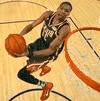emunney wrote:Jez2983 wrote:emunney wrote:
Guess they're oversampling b2bs now to try to build some power into their estimates.
There is literally no intervention that exists that prevents injury.
As I've said 1000 times, load reduction is for risk management and performance enhancement. This is not specifically directed at you, but people seem unable to get past the idea that load management doesn't stop people hurting themselves.
Do you mean to say no intervention that prevents all injury? Surely there are things you can do that can make some types of injury less likely, or is the "risk management" part pure fantasy?
My understanding of load management as practiced as that it's primarily about chronic injuries, specifically the types of repetitive stress injuries that are known to respond to rest. Is the performance aspect the bigger piece, or even the only piece with any validity?
I'll hang up and listen.
Mate, these are like my favourite questions
What you are doing, which lots of people don't, is that you are correctly distinguishing between risk reduction and injury prevention. Load managament ostensibly assists with risk reduction, certainly by reducing accumulated load or even by taking the player off the court, thereby reducing injury opportunity. Tim Gabbett has done some somewhat contentious work on this with the acute vs. chronic workload ratio stuff he's done. If the acute load is >1.5x chronic, injury rates increase, >1.7x greatly increase. I talked to him about this, he said it isn't a bible, if people don't overload they don't improve their performance, it's just another data point to reflect on.
Much of the 'rest' stuff is player specific. If after 2 games, Giannis does a light session and he says he's 4/10 fatigued (I'm being arbitrary here) the S&C staff note this. Does a similar session 4 weeks later, 7/10 fatigued, they may think he's cooked and that may trigger a rest. They'd look at loads of other stuff too, all his GPS/movement data, schedule, team requirements, where the game is, all sorts of stuff.
As for things that respond to rest, outside of that total body load, theoretically tendon issues will feel better with rest, but they still need load to recover. Generally they hate dynamic exercise, but heavy weights are OK. The other one is bony stuff. If he has bony stuff, he just rests.
You also mention 'validity' - it's a really tough concept. Applying research findings is tricky, college athlete samples are not the same as the NBA. And even then, Giannis is not the same as 90% of the NBA. There's 'merit' in load management for risk reduction and performance enhancement that needs to be considered per each individual case. My main point is that people are too absolute with 'load management prevents injury' which isn't a true statement. Rested athletes can still get injured.














